 It was the end of August 2016, and I was in Paris’ Charles de Gualle Airport, with two very tired little girls. We had been up since 4:00am for a big day of travel to our new home in Congo. As we were leaving the elevator, a woman on her way into the elevator stopped me.
It was the end of August 2016, and I was in Paris’ Charles de Gualle Airport, with two very tired little girls. We had been up since 4:00am for a big day of travel to our new home in Congo. As we were leaving the elevator, a woman on her way into the elevator stopped me.
“You’re Canadian Expat Mom,” she said; half statement, half question.
“I am,” I responded, totally shocked that someone in Paris recognized me from my blog.
Unlike myself, the woman that stopped me didn’t look the least bit tired or exhausted from travelling. She looked perfectly Parisian, yet, spoke flawless English, which I later found out was because she grew up as an expat kid in Australia.
In my stunned state, I smiled, slightly flustered, and wished the chic French lady a good day…
Until a few hours later when she ended up sitting right behind me on the eight hour flight to Congo. My kids peeking through through the seats at her gave us a chance to get to know each other a bit. She indeed was Parisian, and her husband worked for the same French company that mine did. She was living in Norway when she found out they would be moving to Africa, and a friend there told her about a blog written by a Canadian(that’s me) in Indonesia, who was also on her way to Congo.
And the rest, as they say, is history.
Frédérique became my first new friend in Congo and I hadn’t even technically arrived yet. We learned the lay of the land together: the good, the bad and the bubbly. 😉
I would be leaving out a significant detail if I were to tell you about my friend without mentioning that she is a super talented artist who has found a ton of inspiration in the local ladies and their colourful fabric.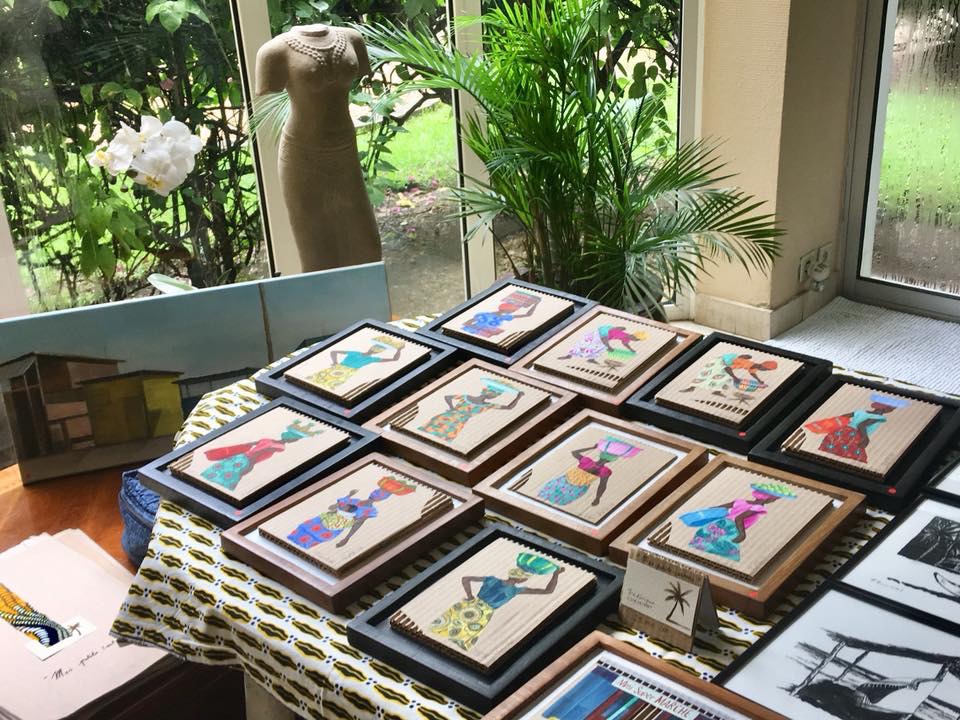 Her paintings have become a bit of a ‘must have’ for the international-locals here in town. The best part is that they’re all done on cardboard because when she first arrived and was feeling inspired, she just grabbed one of the moving boxes she was surrounded by. How’s that for expat creativity!
Her paintings have become a bit of a ‘must have’ for the international-locals here in town. The best part is that they’re all done on cardboard because when she first arrived and was feeling inspired, she just grabbed one of the moving boxes she was surrounded by. How’s that for expat creativity!
This is the one she made for me last year, in my favourite colours.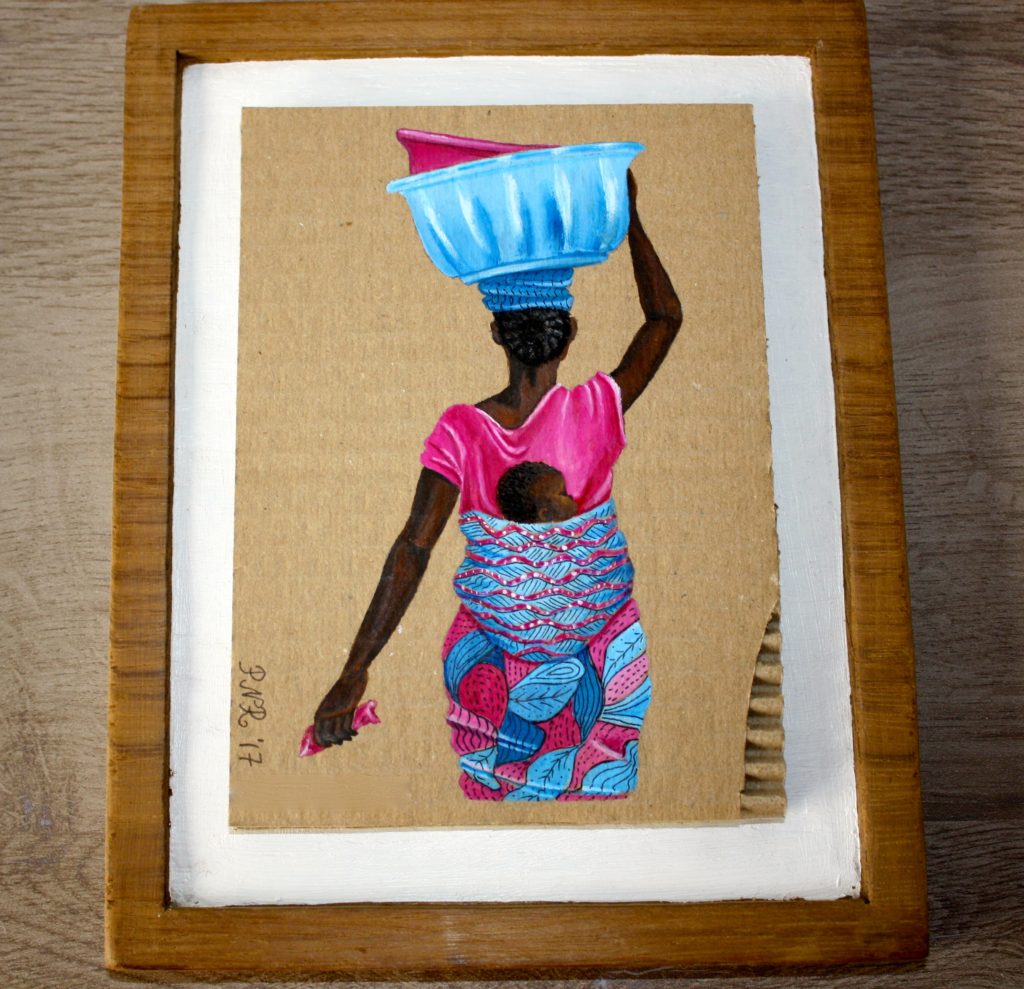 Told you she was good!
Told you she was good!
Fast forward a year and a half later from that day in Paris and now life in Congo seems pretty normal. I started My Expat Kitchen and usually once a week I snag one of my international friends to teach me one of their country’s dishes.
Finding someone French to cook with is the easiest choice I have, seeing as we live on a French compound. I’m one of the very few people here that isn’t French.
But I already knew exactly what I wanted to make.
Last spring when Frédérique hosted Book Club she made the most delicious cannelés Bordelais that I had ever tasted. It’s a little dessert that comes from Bordeaux. I’d tasted my fair share during my five years in France and I usually find them alright, but I’d swap one for a macaron any day. Yet, that night at book club, I was eating those cannelés like chips! I couldn’t stop.
Upon request, Frédérique was happy to make them with me and when I saw her pull out the rum for the recipe, I understood why I liked them so much.
So here we go…
French Cooking in Africa with Frédérique
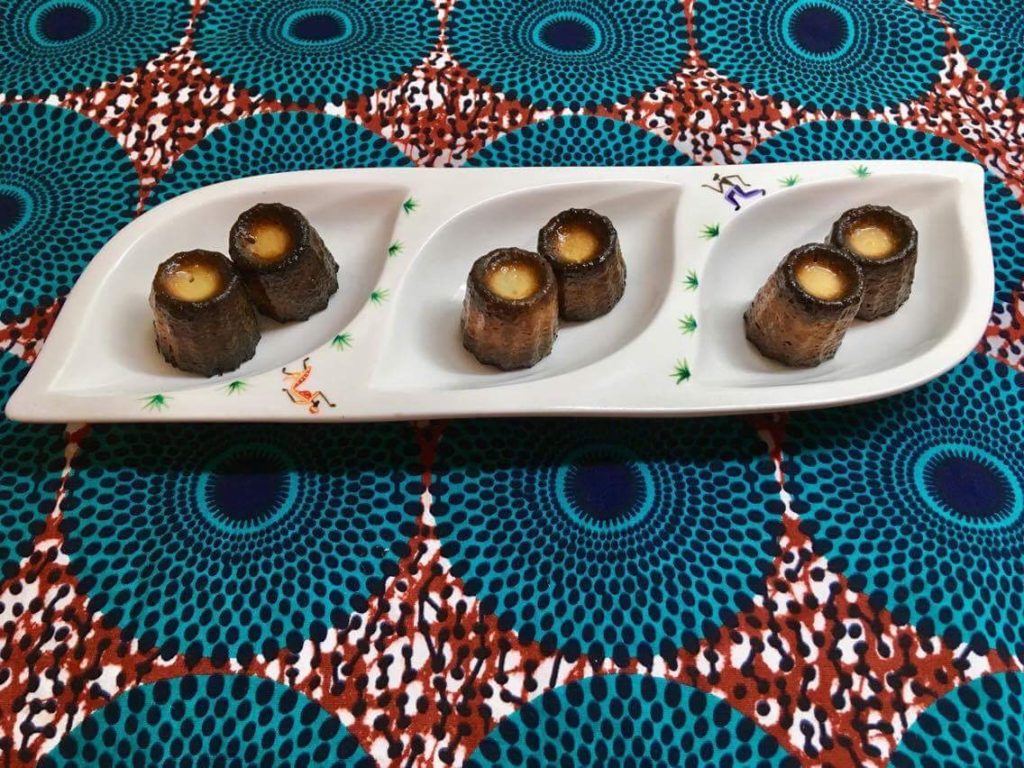 The batter for this recipe has to sit for about six hours. So it’s the perfect thing to throw together at night, leave it in the fridge, pop it in the oven the next morning and easily be mistaken for Martha/ Nigella/ Siba–insert kitchen wizard from your chosen country.
The batter for this recipe has to sit for about six hours. So it’s the perfect thing to throw together at night, leave it in the fridge, pop it in the oven the next morning and easily be mistaken for Martha/ Nigella/ Siba–insert kitchen wizard from your chosen country.
Frédérique arrived with a copy of the recipe for me, with a hand painted cannelé on top. It was perfect, but this is where I should warn you that the French use a different measuring system for baking than I grew up with in Canada.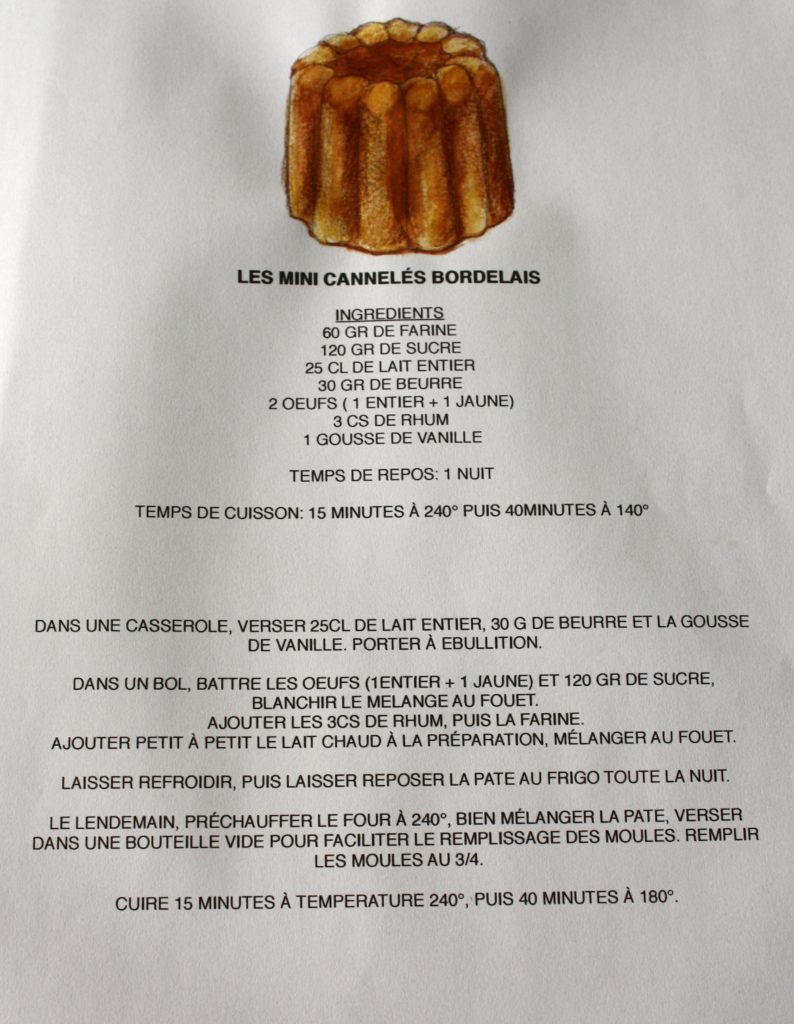 Instead of using cups to measure, everything is weighed in grams. Lucky for us, I had my electric scale from France.
Instead of using cups to measure, everything is weighed in grams. Lucky for us, I had my electric scale from France.
We gathered our ingredients.
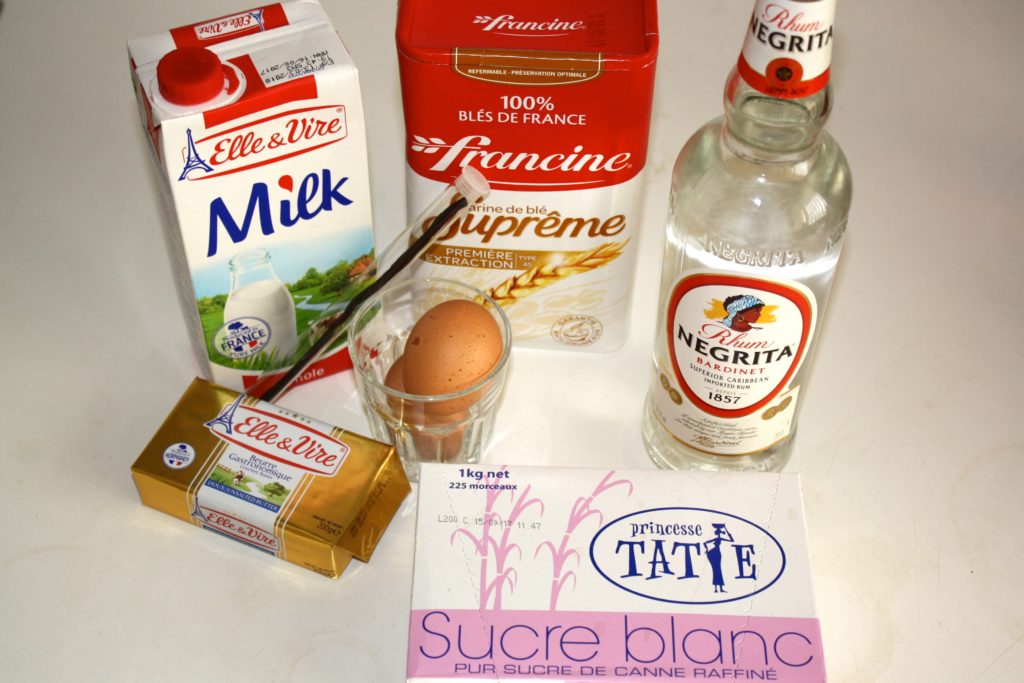 Frédérique spared no expense and treated us to an actual vanilla bean, which in Congo, where groceries are at a premium, could probably be exchanged for a bar of gold!
Frédérique spared no expense and treated us to an actual vanilla bean, which in Congo, where groceries are at a premium, could probably be exchanged for a bar of gold!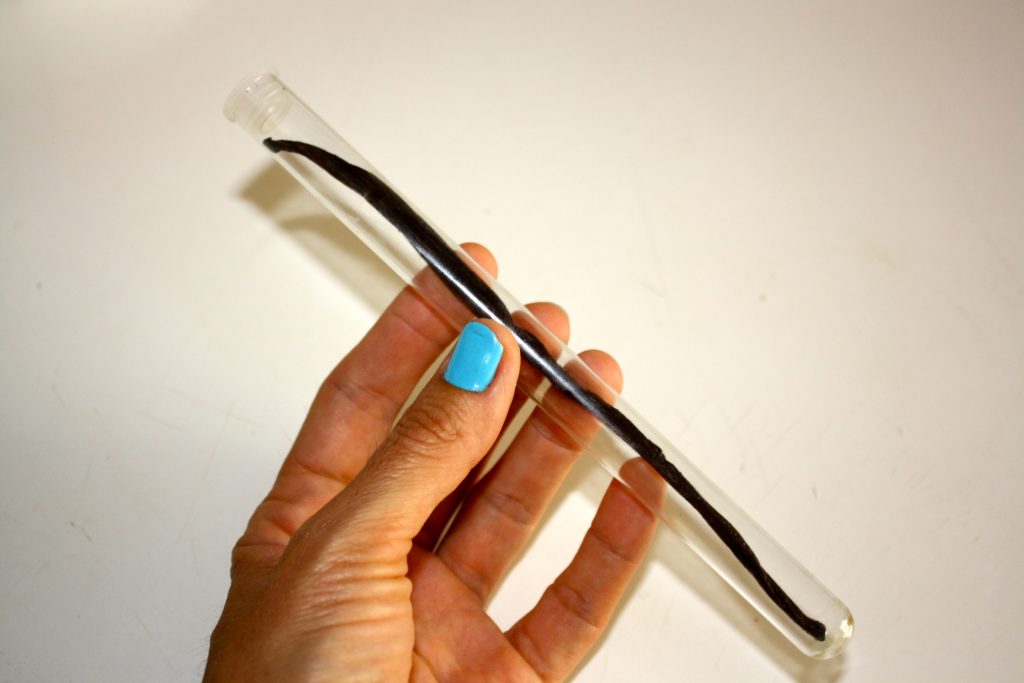 I had a look at our ingredients.
I had a look at our ingredients.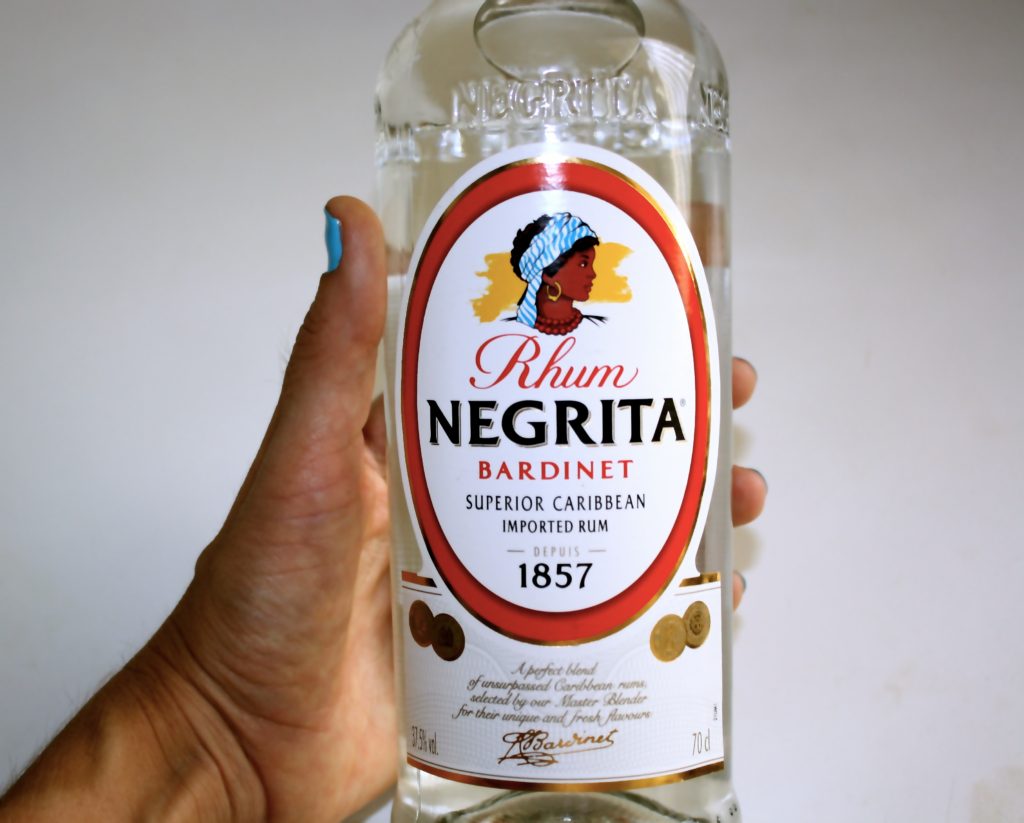 Vanilla and rum. I was sold.
Vanilla and rum. I was sold.
We started by measuring out 25CL/250ML of whole milk.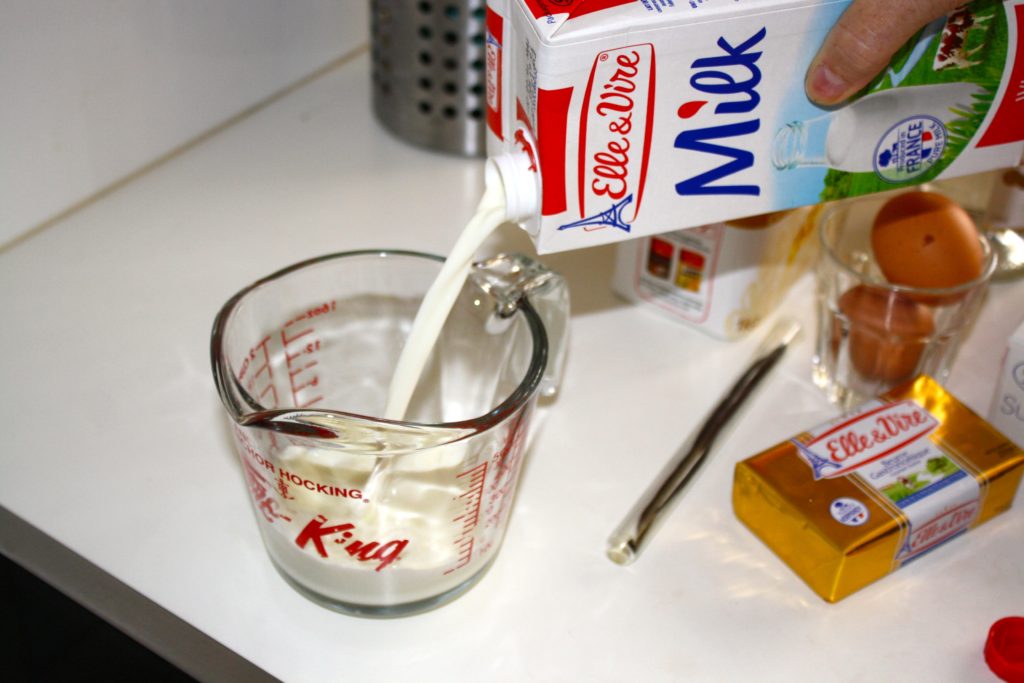 Next, heat it in a pot.
Next, heat it in a pot.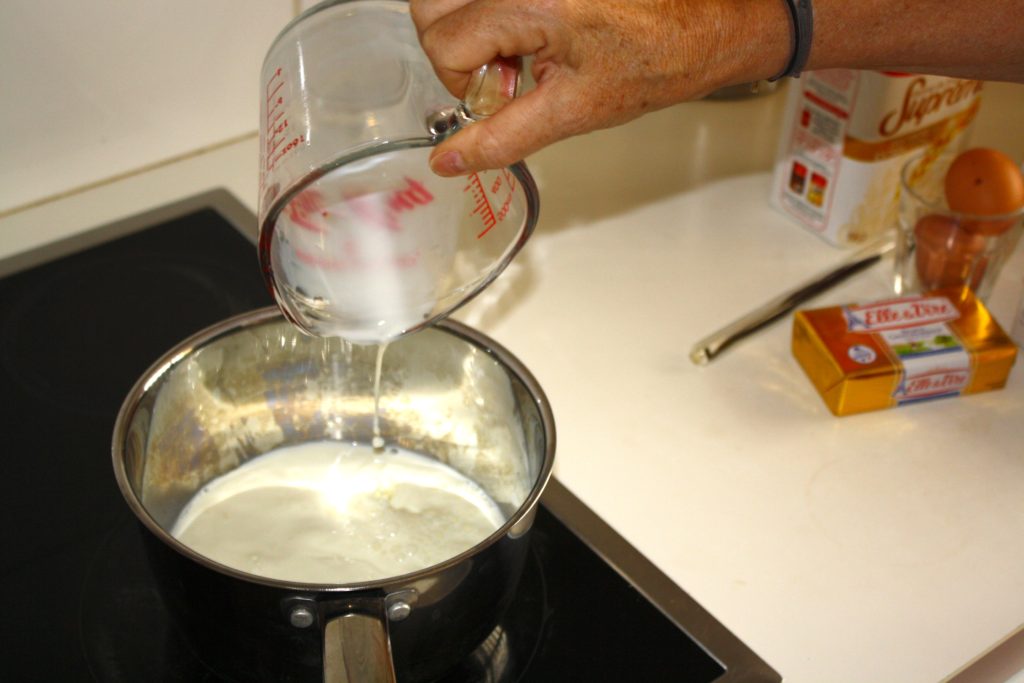 Weight your butter.
Weight your butter.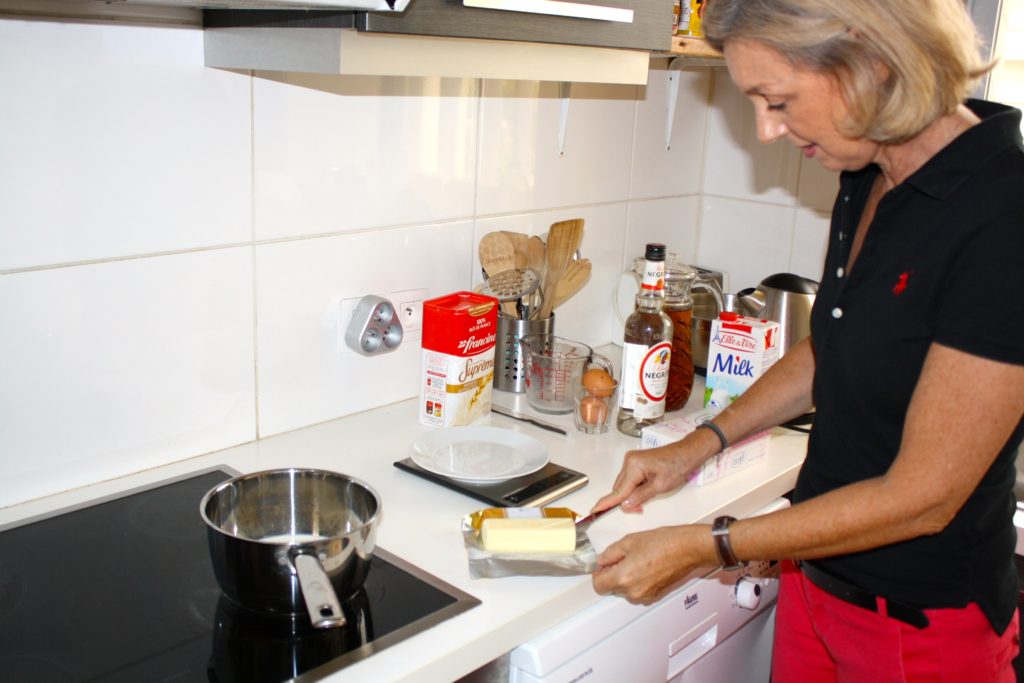 The beauty of using a scale to measure is that it’s far more precise, making baking pretty fool-proof. 30 grams, right on the mark.
The beauty of using a scale to measure is that it’s far more precise, making baking pretty fool-proof. 30 grams, right on the mark.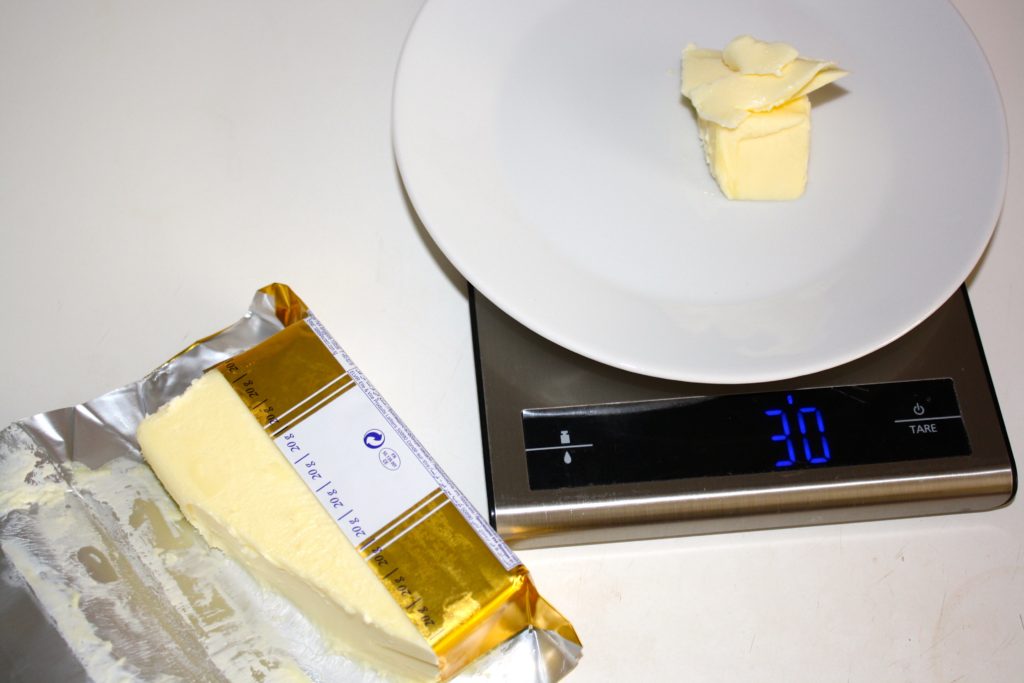 Add the butter to the milk, on medium heat. Then slice open your vanilla bean with a sharp knife and scrape out the vanilla goodness.
Add the butter to the milk, on medium heat. Then slice open your vanilla bean with a sharp knife and scrape out the vanilla goodness.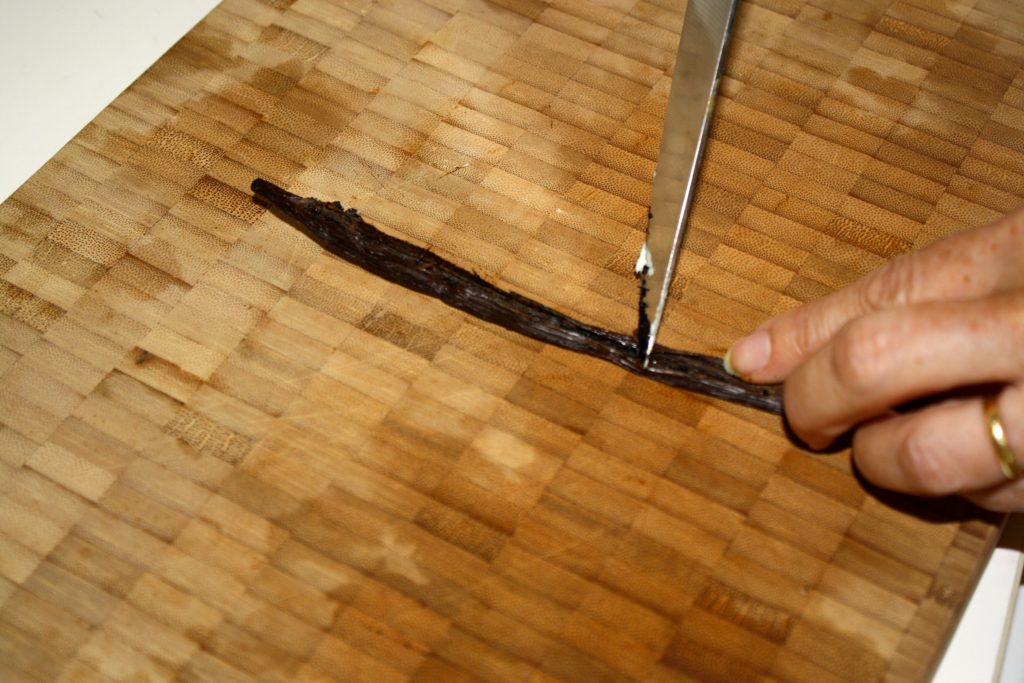 Put the vanilla scrapings into the pot, then throw the bean in too for extra flavour. You can take it out at the end.
Put the vanilla scrapings into the pot, then throw the bean in too for extra flavour. You can take it out at the end. 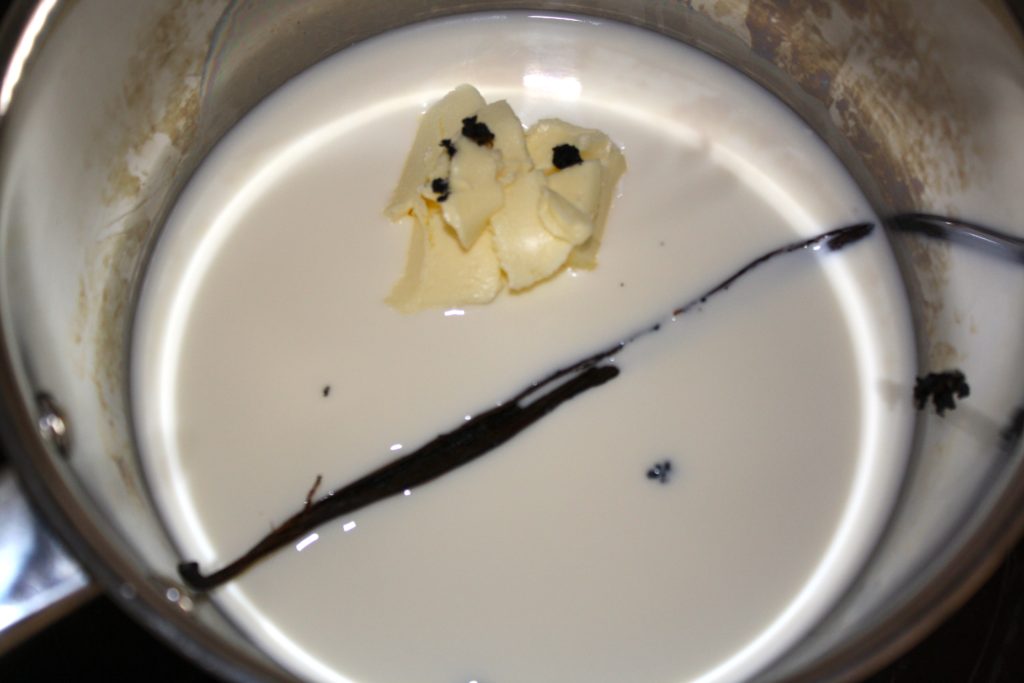 Stir away until everything is melted.
Stir away until everything is melted.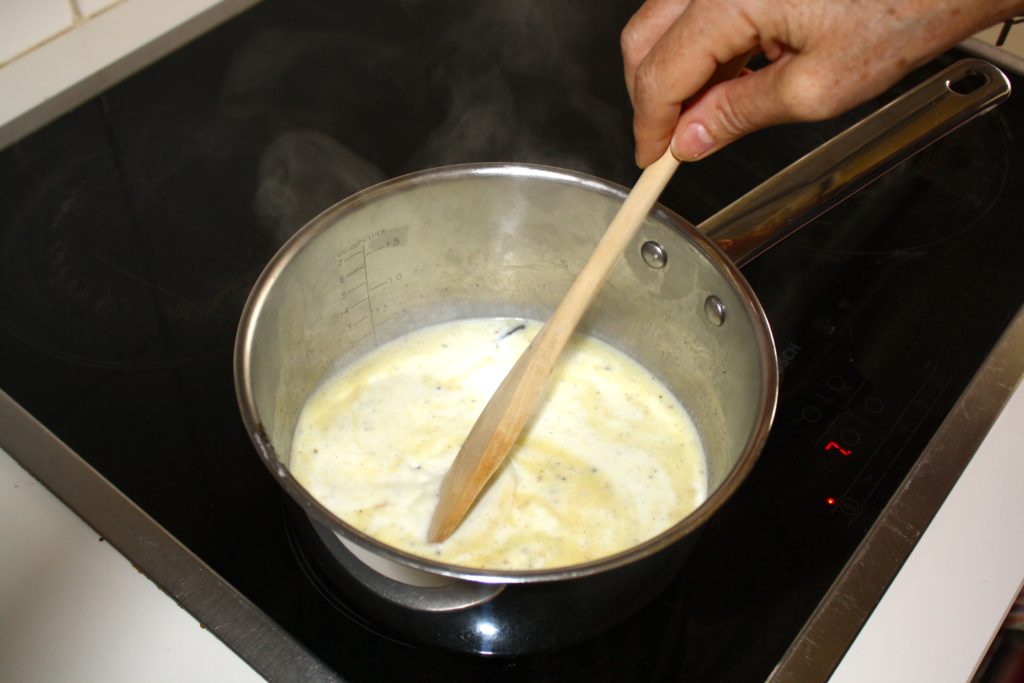 And when it comes to a boil, remove it from the heat.
And when it comes to a boil, remove it from the heat.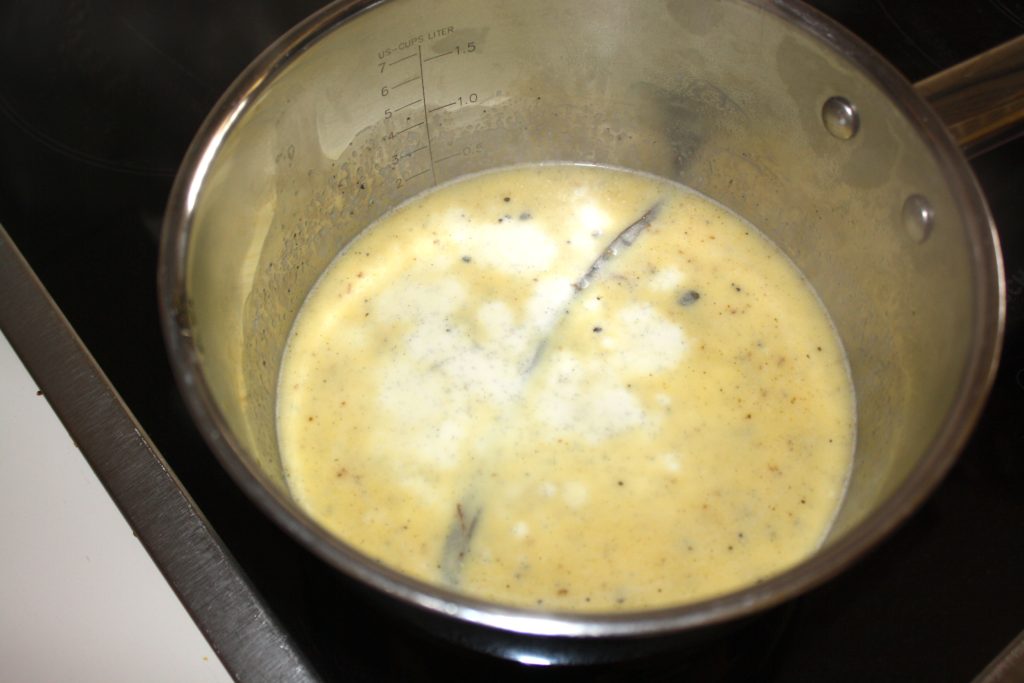 Leave that to the side and in a separate bowl, whisk together one whole egg, plus one yolk.
Leave that to the side and in a separate bowl, whisk together one whole egg, plus one yolk.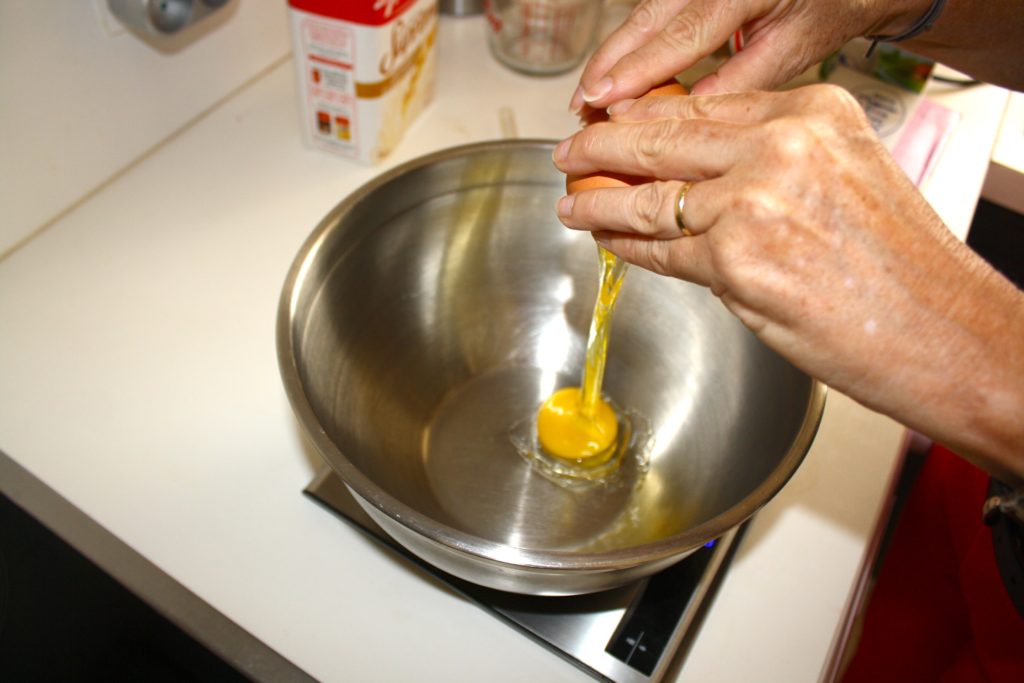 Next weigh the sugar. Which is easy, unless you live in Congo. I don’t really use white sugar, so I went to pick some up for this recipe, and my options were sugar cubes or a giant sac that would last me a lifetime. With cupboard space minimal, I figured crushing sugar cubes would be easy enough….
Next weigh the sugar. Which is easy, unless you live in Congo. I don’t really use white sugar, so I went to pick some up for this recipe, and my options were sugar cubes or a giant sac that would last me a lifetime. With cupboard space minimal, I figured crushing sugar cubes would be easy enough….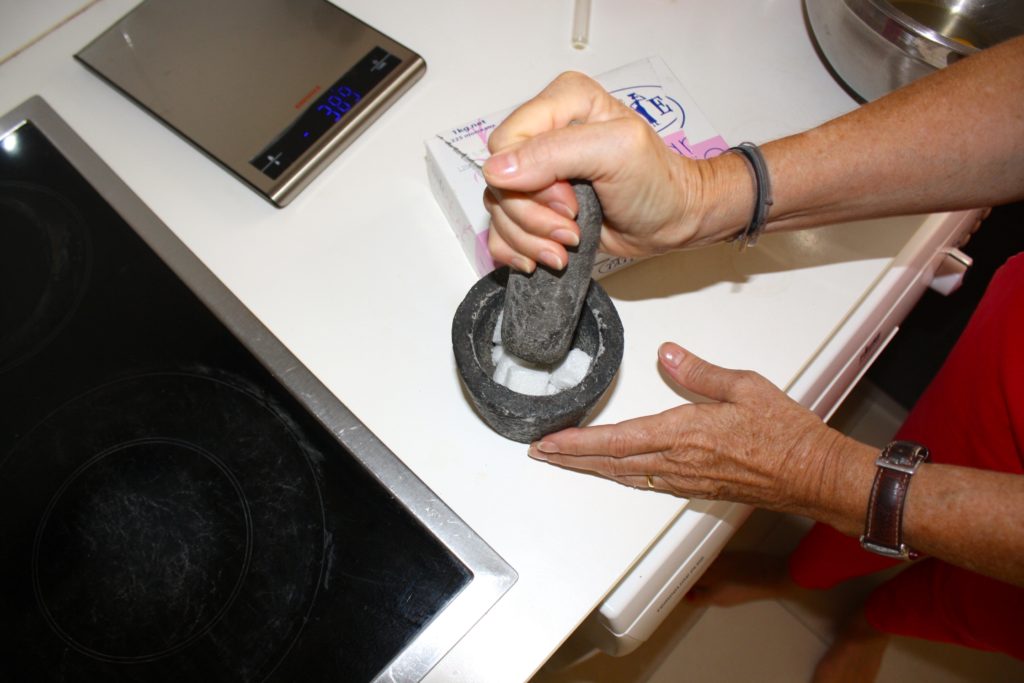 Wrong. Turning sugar cubes to powder with a mortar and pestle is actually quite difficult, so we moved to the blender.
Wrong. Turning sugar cubes to powder with a mortar and pestle is actually quite difficult, so we moved to the blender.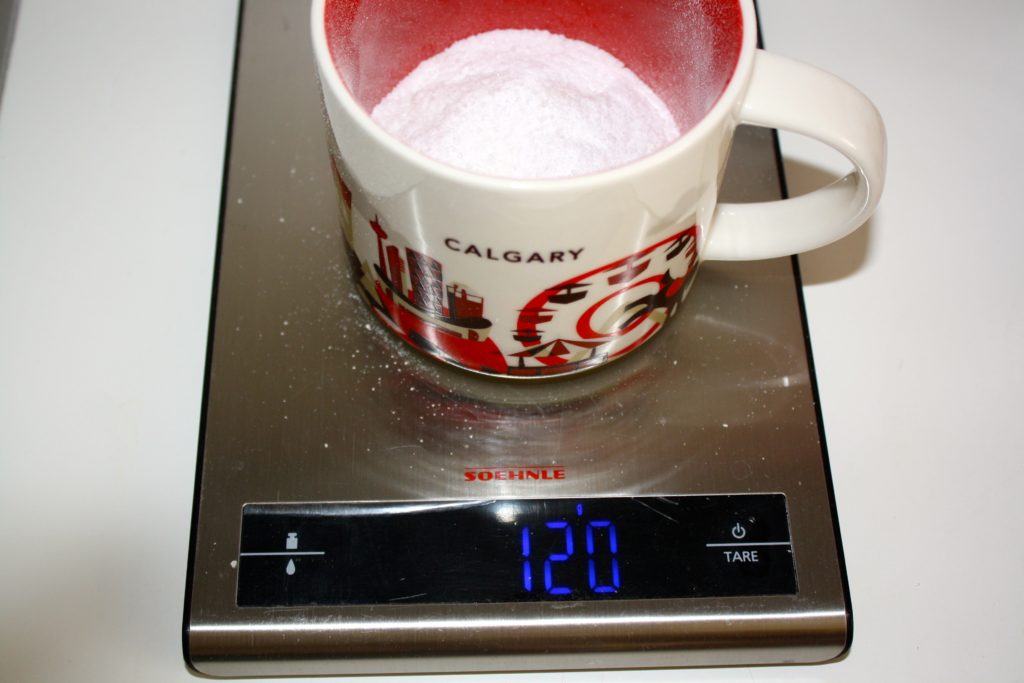 120 grams of sugar in the lovely Calgary cup that was gifted to us a few years back. Then into the eggs.
120 grams of sugar in the lovely Calgary cup that was gifted to us a few years back. Then into the eggs.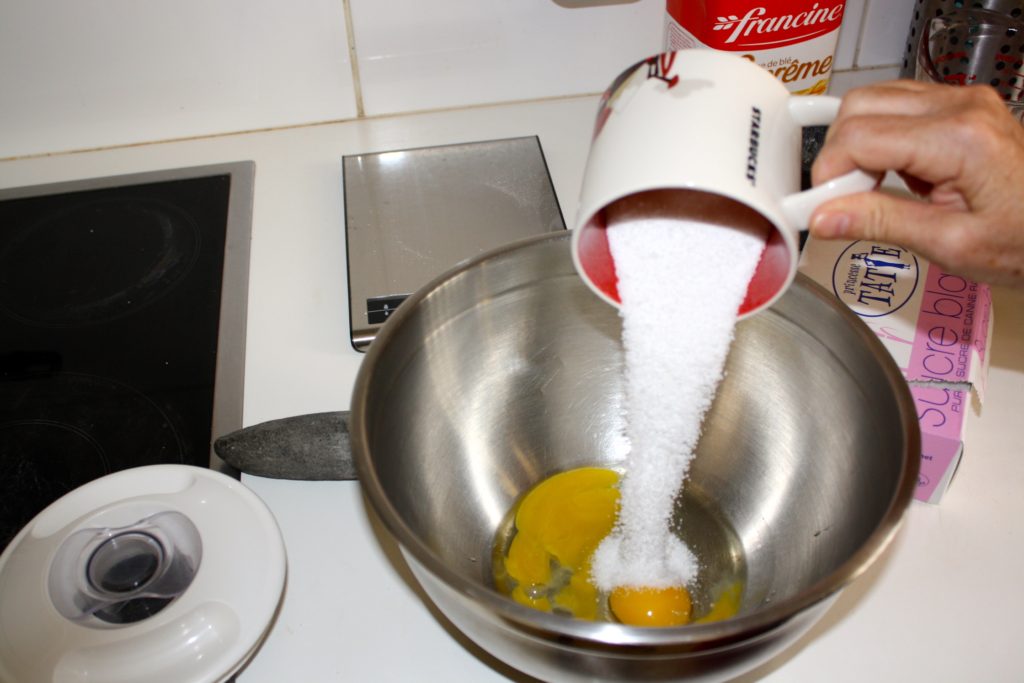 Mix that up.
Mix that up.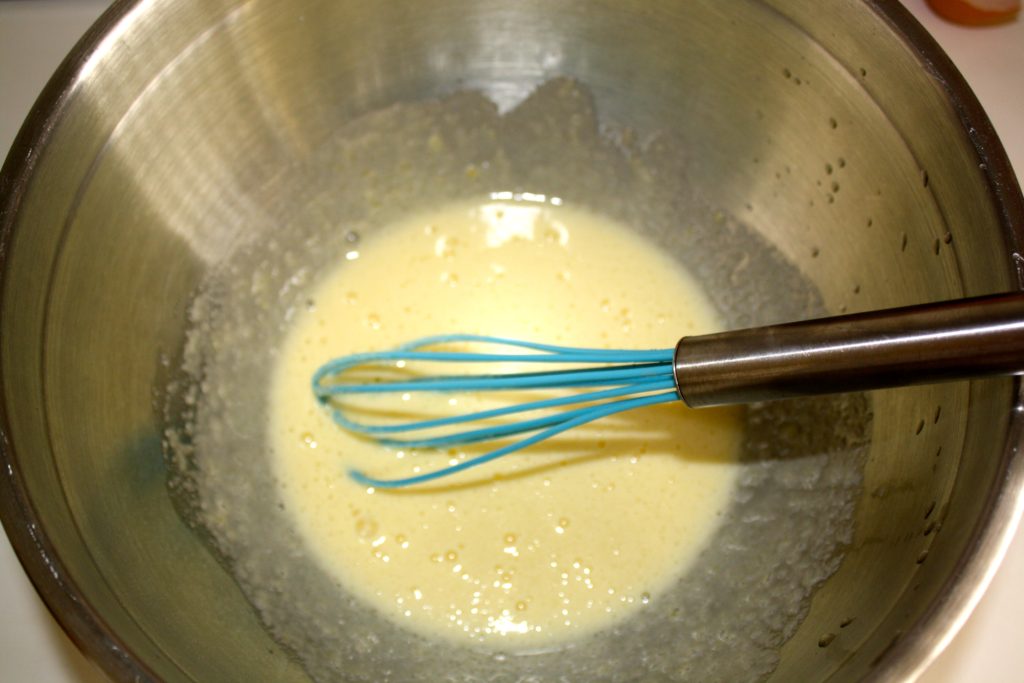 Then get ready for the best part. The rum! Three soup spoons, but I won’t tell if you add a splash more.
Then get ready for the best part. The rum! Three soup spoons, but I won’t tell if you add a splash more.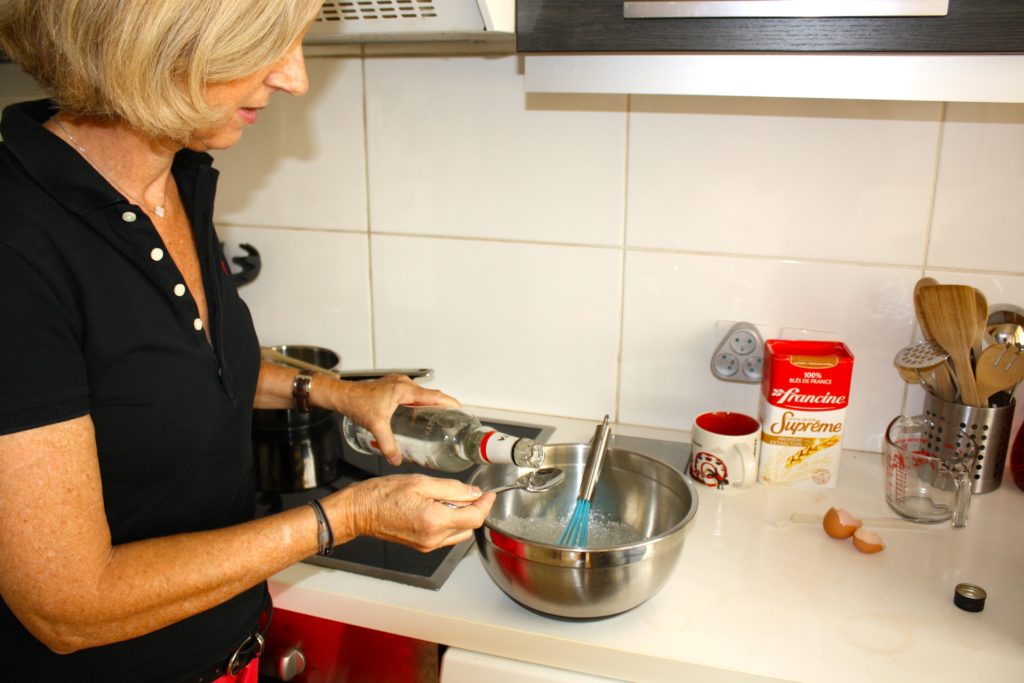 Weight out 60 grams of flour, add it to the eggs and sugar, then mélanger(mix).
Weight out 60 grams of flour, add it to the eggs and sugar, then mélanger(mix).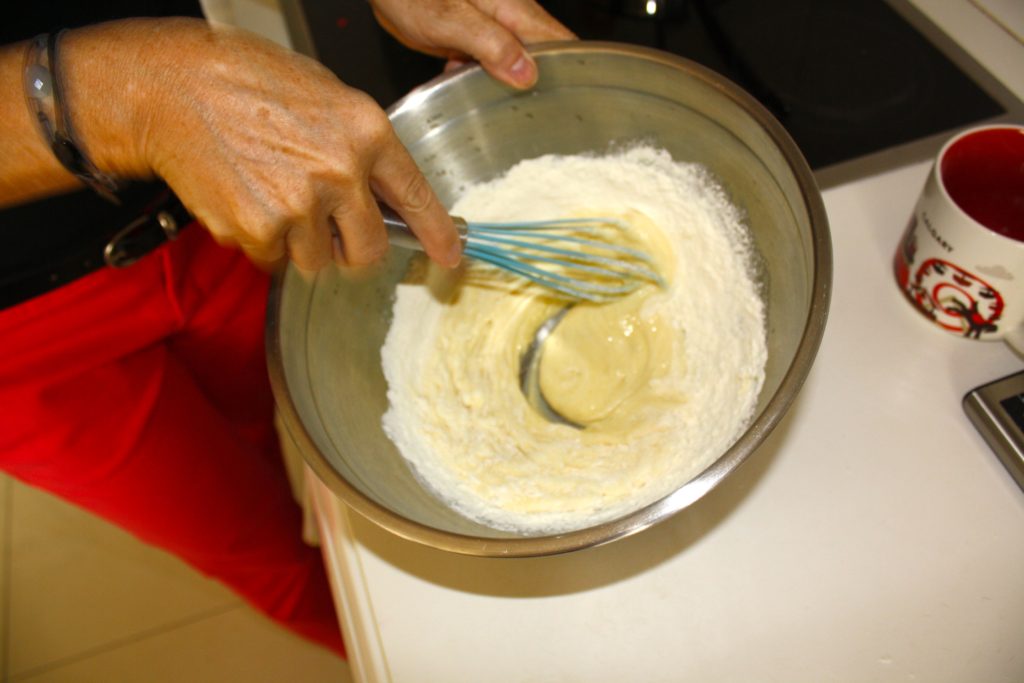 Now it’s time to add the warm milk mixture to the eggs and sugar, but do it little by little, because you don’t want your eggs to turn into an omelet.
Now it’s time to add the warm milk mixture to the eggs and sugar, but do it little by little, because you don’t want your eggs to turn into an omelet.
Et voila! C’est tout…for now.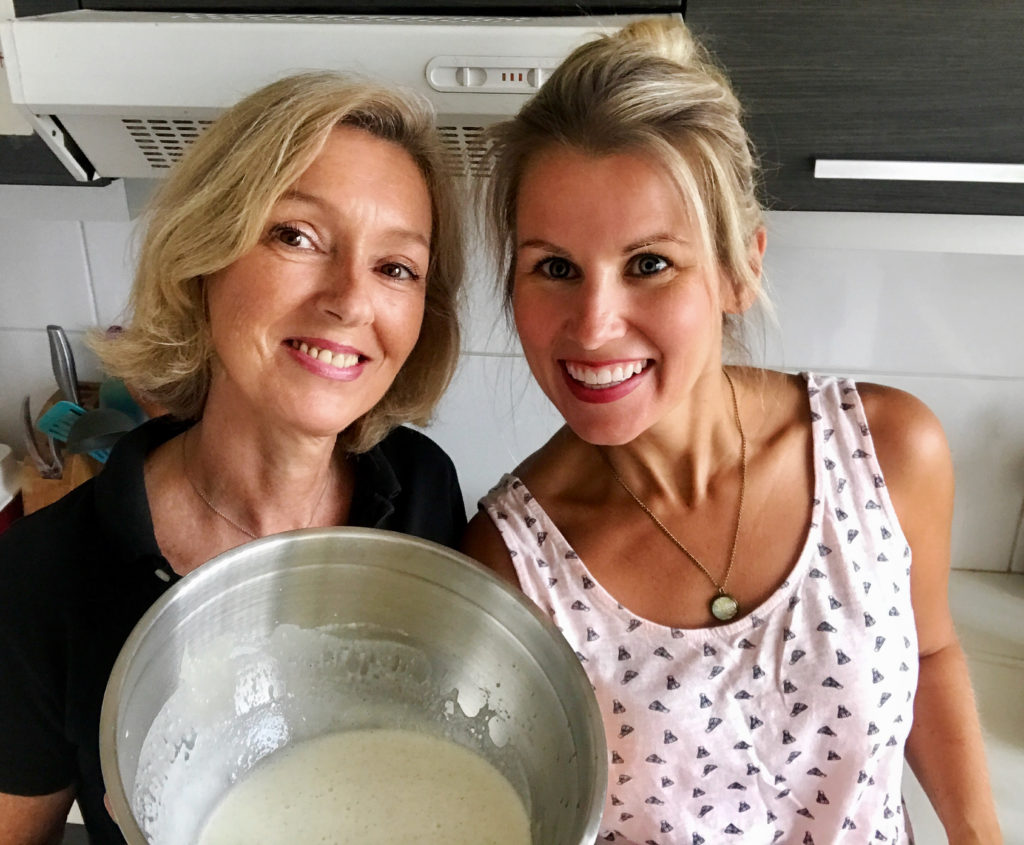 We put that into an airtight container and popped it into the fridge until the next day.
We put that into an airtight container and popped it into the fridge until the next day.
When we took it out, it had a sweet aroma, with hints of vanilla and just a little whisper of rum.
Give it a little stir and preheat your oven to 240°C degrees(465°F).
You want the overn really hot at the beginning so that everything caramelizes. Then later, the heat gets turned down so the inside cooks without burning. You end up with a nice chewy caramelized outside and soft squishy inside.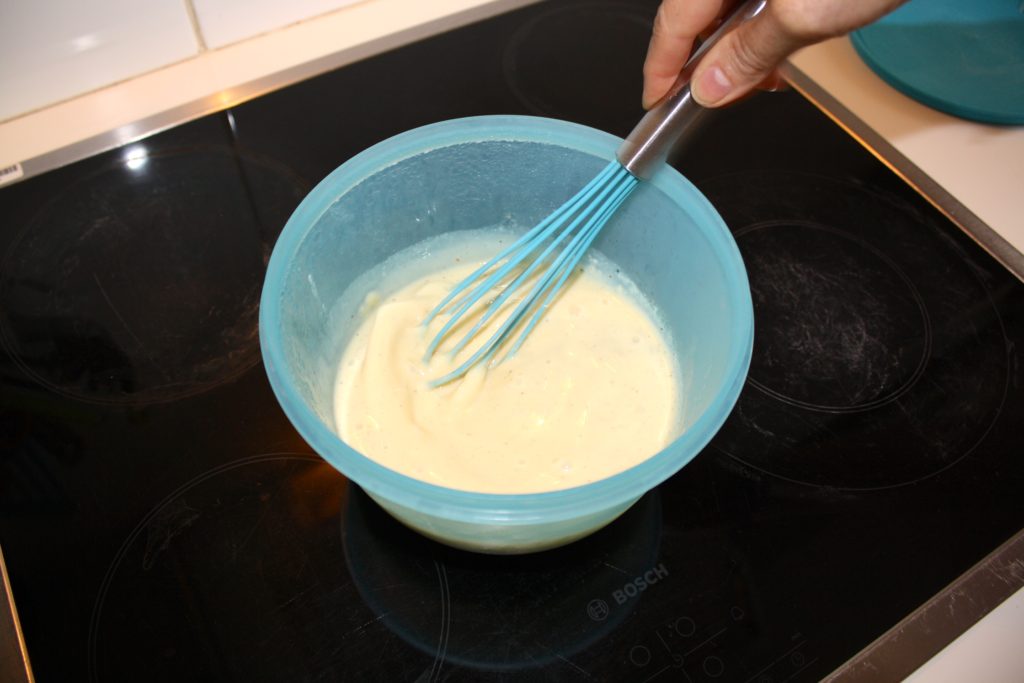
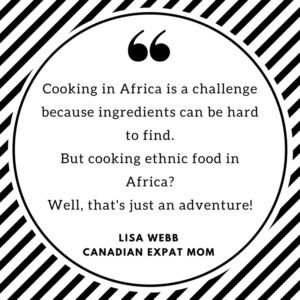 The next step, once again, involves some African-kitchen innovation. If you’re fancy, you might own a piping bag, or some other kitchen tool that would get the batter into the small cannéles molds. We did not have access to such a luxury, so we got creative.
The next step, once again, involves some African-kitchen innovation. If you’re fancy, you might own a piping bag, or some other kitchen tool that would get the batter into the small cannéles molds. We did not have access to such a luxury, so we got creative.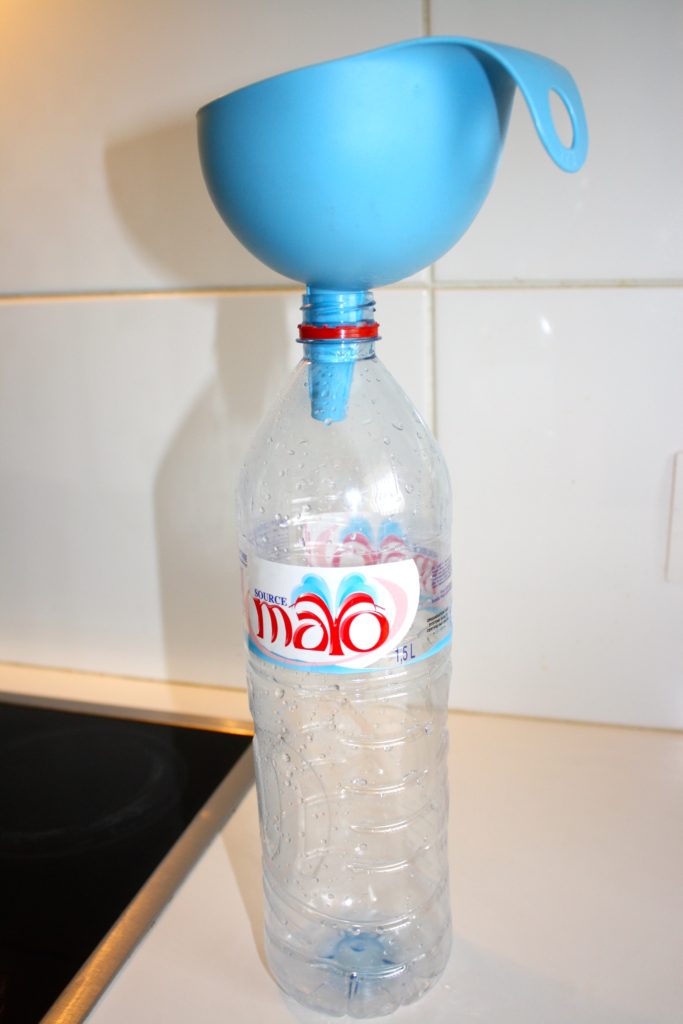 We poured the batter into a water bottle, making it easier to fill the molds without the batter going everywhere. Genius, really.
We poured the batter into a water bottle, making it easier to fill the molds without the batter going everywhere. Genius, really.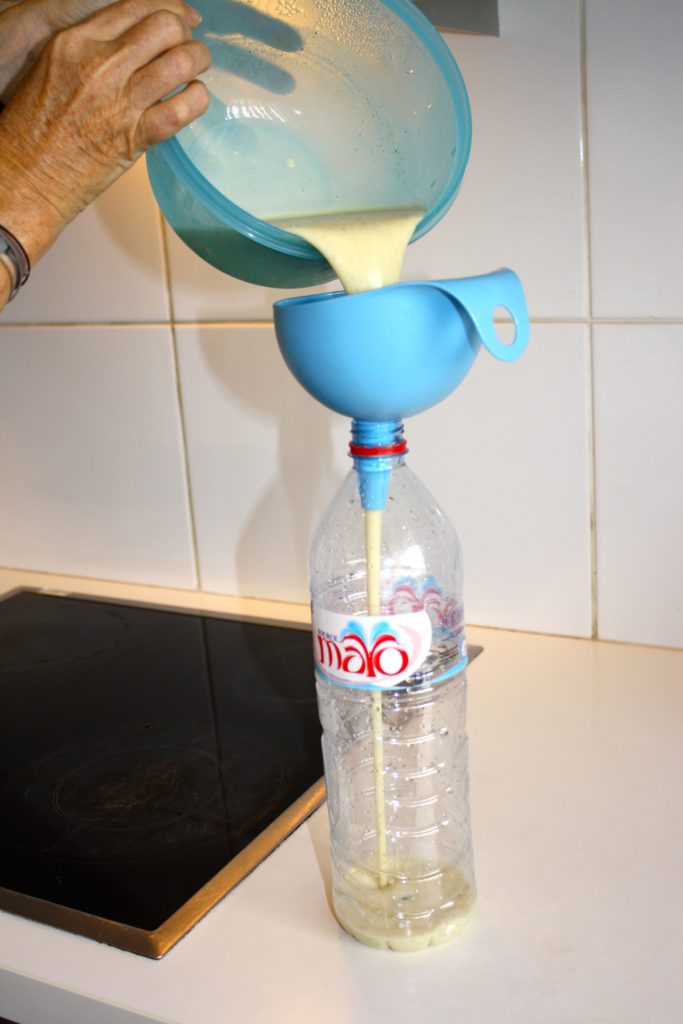 One the batter is in the bottle, you can remplissage des moules.
One the batter is in the bottle, you can remplissage des moules.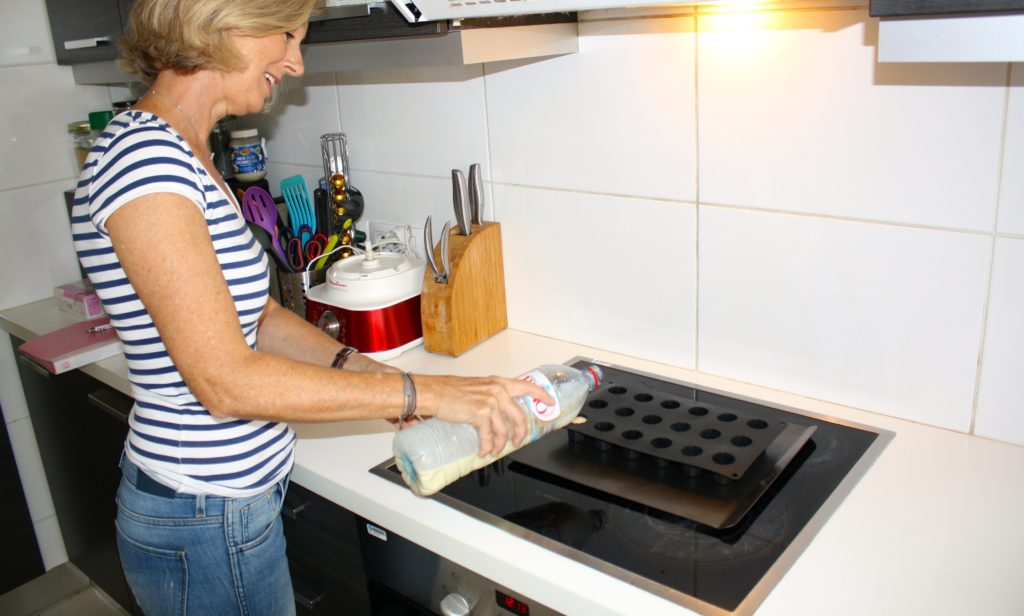
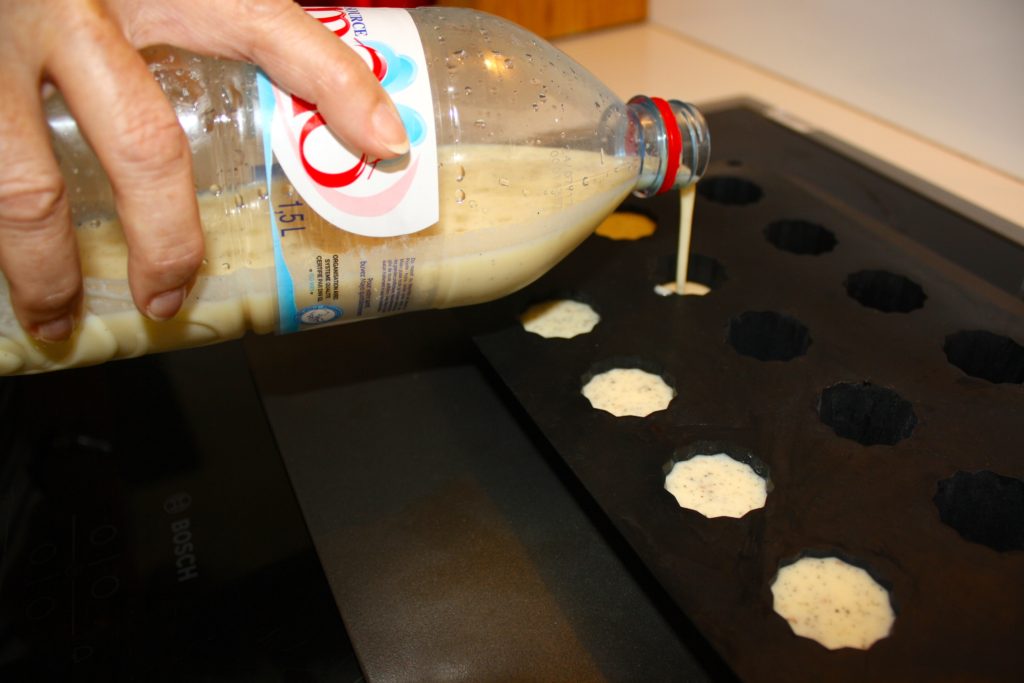 You want to leave a little space at the top(about 1cm or so) otherwise they will overflow and pop right out of the mold.
You want to leave a little space at the top(about 1cm or so) otherwise they will overflow and pop right out of the mold.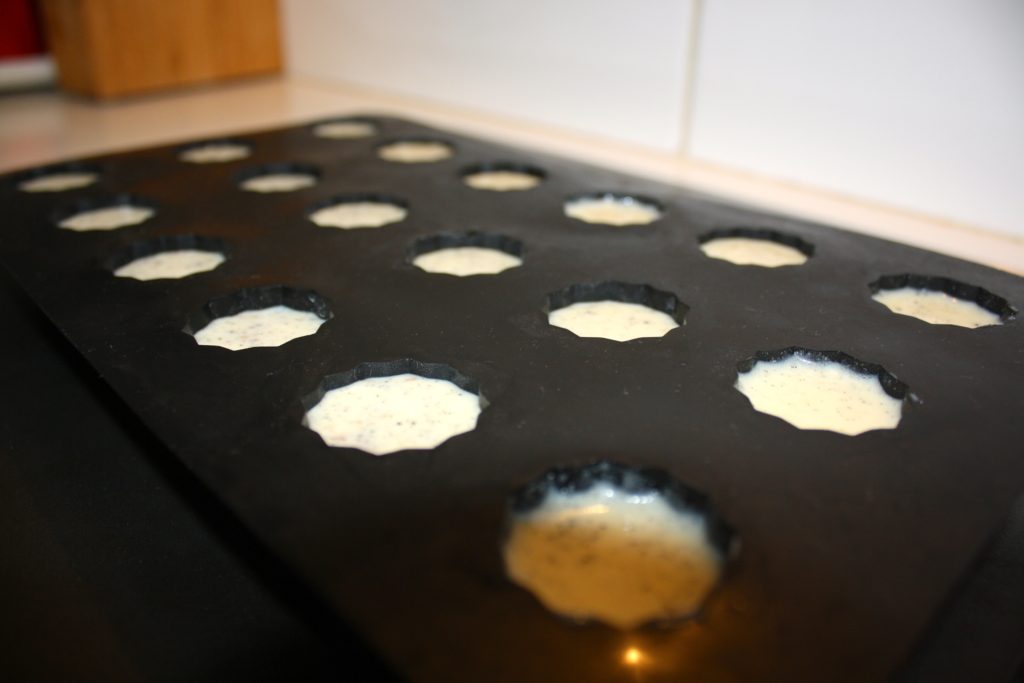 Pop them into the oven and set your timer for 15 minutes.
Pop them into the oven and set your timer for 15 minutes.
After 15 minutes, turn the temperature down to 140°C/285°F for another 40 minutes so the inside can cook.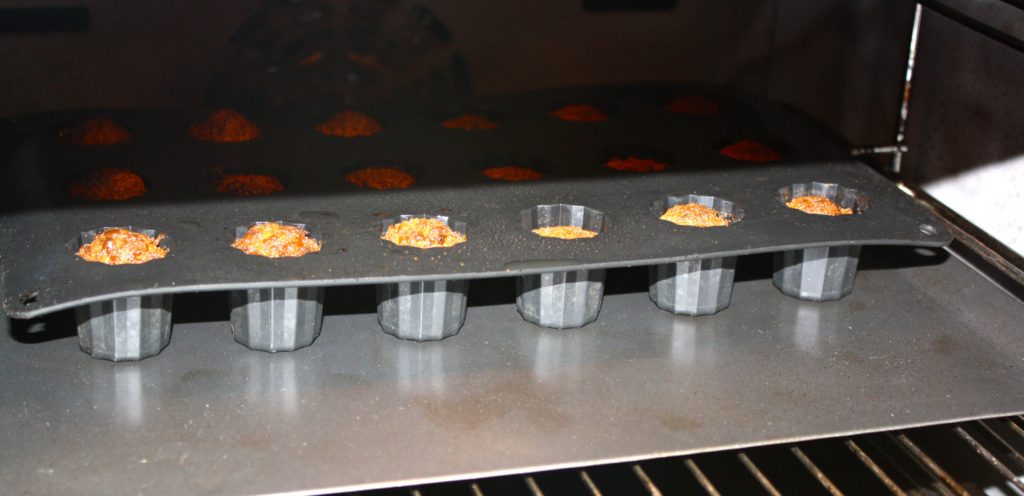
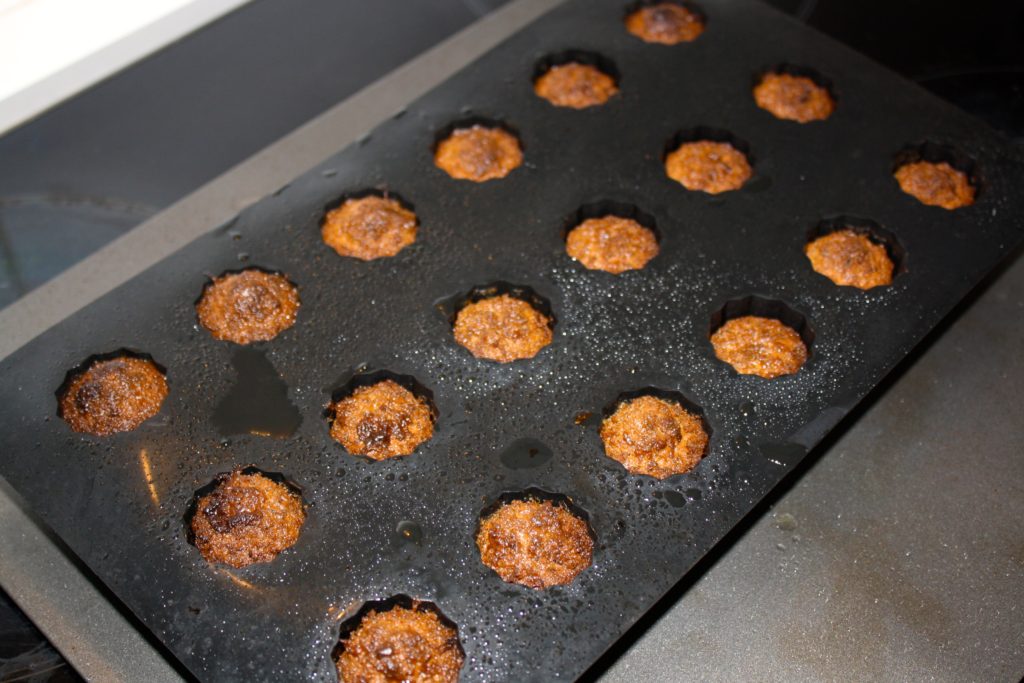 When they’re done, turn over the pan and get your coffee ready. You serve them inverted, so the top actually becomes the bottom.
When they’re done, turn over the pan and get your coffee ready. You serve them inverted, so the top actually becomes the bottom.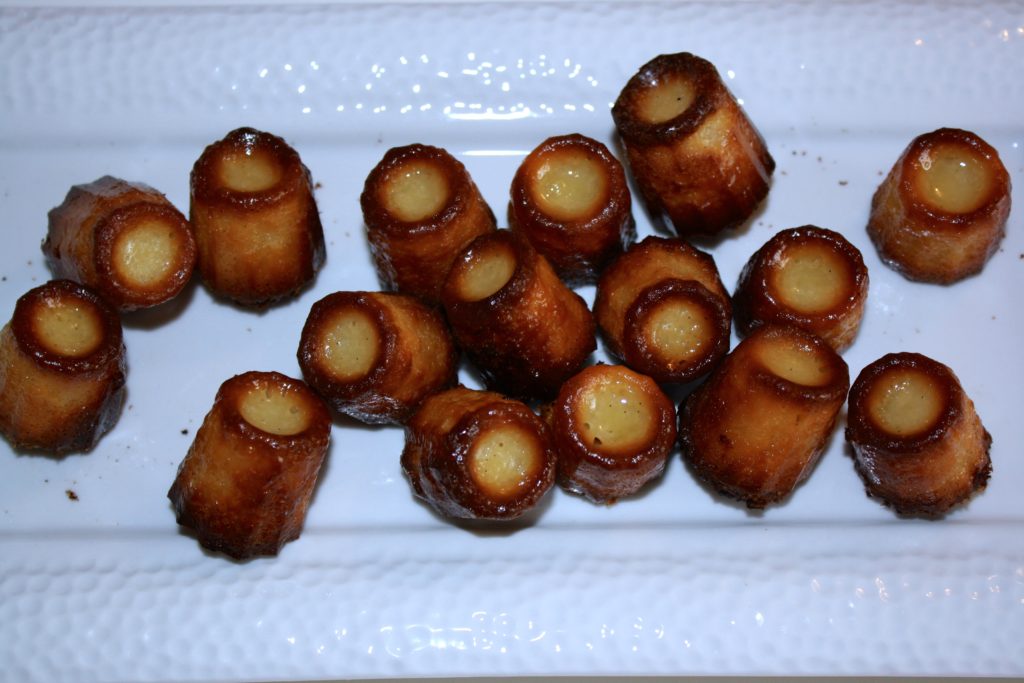 These little guys are so good!
These little guys are so good!
It might be worth noting that these are the mini version but both Frédérique, myself, and everyone in my house, prefer these to the full size ones. There just seems to be more caramel to them, they’re chewier, and maybe subconsciously I feel less guilty about eating five of them in one sitting.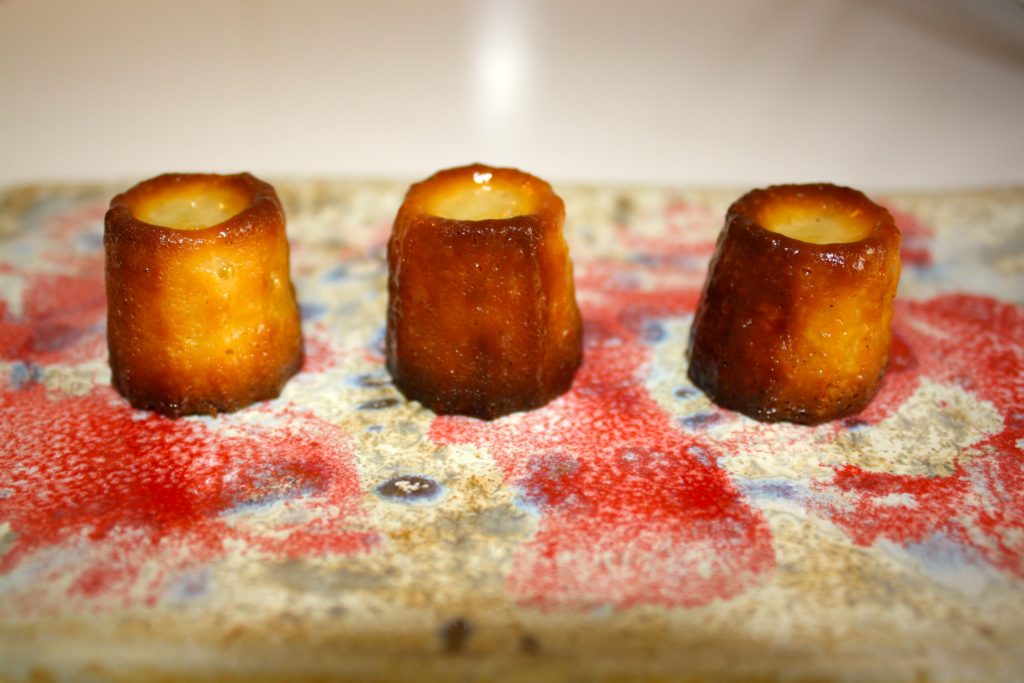 Thanks Frédérique for baking with me. I bet back in Norway when you read that Canadian girl’s blog you never guessed you’d be on it baking Cannelés Bordelais in Congo a short time later!
Thanks Frédérique for baking with me. I bet back in Norway when you read that Canadian girl’s blog you never guessed you’d be on it baking Cannelés Bordelais in Congo a short time later!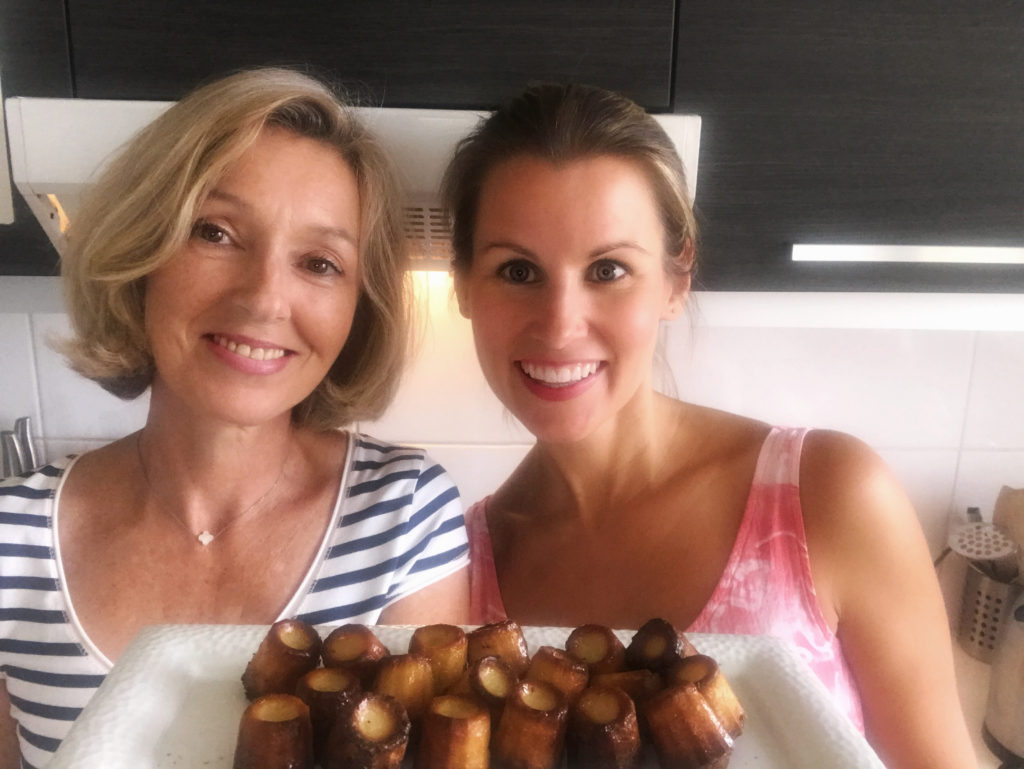 *I should mention that Frédérique’s cannelés usually stand up straight…I think there was something wonky with my oven’s heat. But they all tasted delicious…even the ones that were a little tipsy. Must have been the rum. 😉
*I should mention that Frédérique’s cannelés usually stand up straight…I think there was something wonky with my oven’s heat. But they all tasted delicious…even the ones that were a little tipsy. Must have been the rum. 😉
Cannelés Bordelais
Ingredients
60 grams flour
120 gr sugar
25 cl/250ml whole milk
30 gr butter
2 eggs(1 full, 1 yolk)
3 tbsp rum
1 vanilla bean
Directions
In a pot add milk, butter and vanilla bean(opened and scraped) and heat on medium. Stir until it comes to a boil and remove from heat.
In a separate bowl, whisk eggs(1 whole, 1 yolk), sugar until it gets a bit fluffy.
Add rum. Then flour. Whisk again.
Little by little add the warm milk mixture. Do this slowly.
Rest overnight
Stir and pour into cannelé molds, filling each one about 3/4.
Cook for 15 minutes at 240°C/465°F, then 40 more minutes at 180°C/356°F
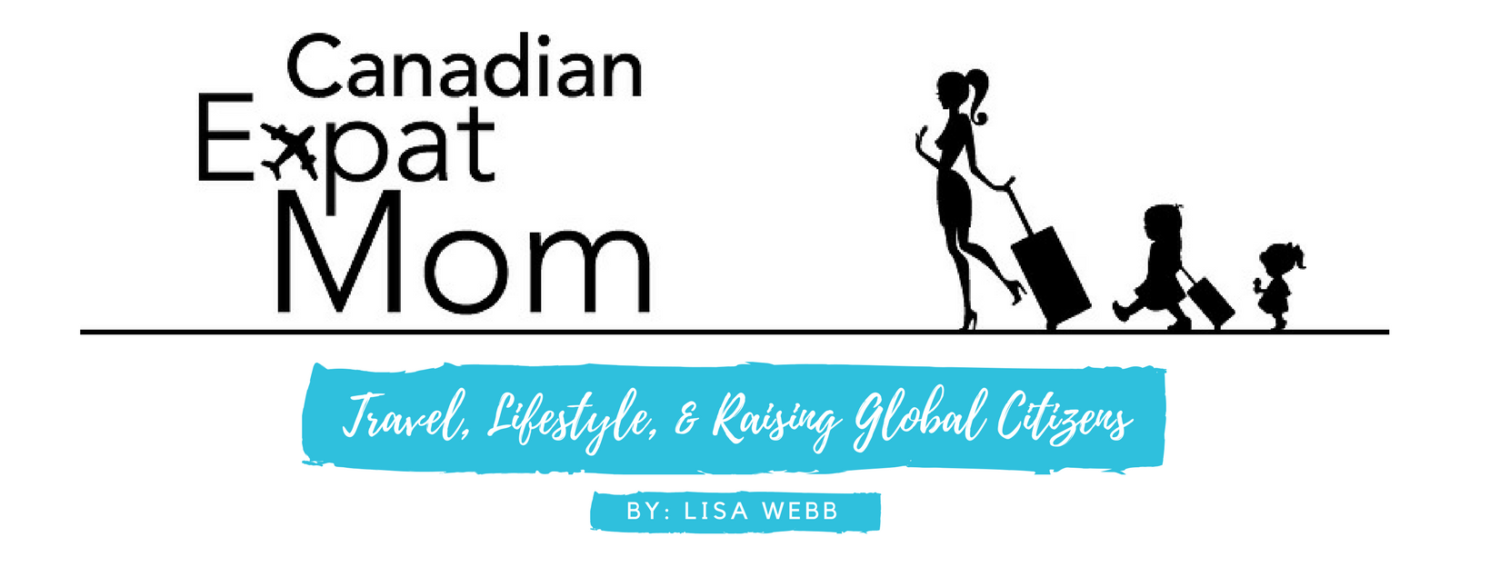
Where did she get that pan from? Never seen one before.
In France you can get them anywhere that you’d buy a cookie sheet. In Canada I’d try a specialty baking store maybe? If they sell macaron baking sheets you might be able to find these…or there’s always the magic of online shopping. 😉
Will never bake cannelés without thinking of our African experience! Merci ma chérie!
Me too! 🙂